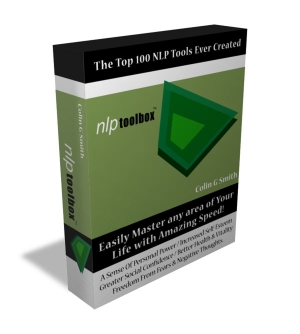-=-=-=-=-=-=-=-=-=-=-=-=-=-=-=-=-=-=-
Copyright: Colin G Smith
http://www.NLPToolBox.com/special_reports/hsr.htm
-=-=-=-=-=-=-=-=-=-=-=-=-=-=-=-=-=-=-
The mind learns fast. A very powerful way to view life is to
experience everything as a learning experience. I think it
was Dr. Richard Bandler (co-creator of NLP) who first made
me realise that Phobias are in fact a learned response. The
mind of the Phobic has learned to associate a stimulus (eg a
Wasp) to a response (eg Panic!)
The more you ponder this idea the more profound you will
realise the implications.
And here's the deal. Does a person develop a phobia of wasps
over time? You know, do they see a wasp one day and then the
next week they see another and decide they don't like them
and get more and more afraid of them?
No. Phobias are 'learned' very, very fast. Out of
consciousness, in less than half a second!
They have an intense emotional response which becomes
associated/anchored to the stimulus in such a way that that
state is AUTOMATICALLY triggered whenever they
see/hear/feel/smell/taste the stimulus again!
This is incredible! The persons mind will from then on
automatically go into a very altered state, within half a
second of experiencing the stimulus.
Now I think you'd agree, phobias aren't exactly useful,
right?
But, what if you could use that same Stimulus/Response
mechanism to create automatic states of Joy, Ecstasy, Fun
and Bliss.
Would that be useful to you in any area of you life? ;)
Now for sure they are many other ways of creating effective
change. Some methods use different concepts and are slower
to implement. With this article I wanted to introduce you
to the half-second rule concepts because they are less well
known than other "change-technologies" and they lend
themselves well to generating more fun because they are
playful by design.
The following technique is a really fascinating NLP tool
because it makes great use of your unconscious resources.
I only discovered it recently and was surprised to learn
that many 'NLP veterans' didn't know about it either!
Merging Metaphors
(Adapted from a technique called 'Spinning Icons' developed
by Joe Munshaw and Nelson Zink.)
1. Select a problem state.
2. As you think about your problem state what visual image
comes to mind? Notice where it is located in space.
3. Break your current state: eg) Remember you phone number
backwards or look up and notice the patterns on the ceiling.
Now think about the desired resource state (or outcome, or
goal) you would like instead. Notice how you represent this
as a visual image. Pay attention to where it is located in
space.
4. Now allow your mind to turn the first picture (problem
state) into a metaphorical symbol or icon. Keep it in the
same location in space. (This visual metaphor could be quite
complex or it may be as simple as a colour. Just trust your
unconscious.)
TOP TIP: It can be useful to ask yourself, "What is this
problem state like?" This often allows a metaphorical
representation to arise.
5. Do the same thing with the desired resource state you
selected in step 3, making sure to place the new metaphor
symbol in the same location in space as the original image.
6. Now see the two metaphor symbols at the same time
noticing their locations in space. Next slowly rotate them
around each other. Keep rotating them around each other and
do so faster and faster. Do this spinning for about 10
seconds allowing the rotation to be so fast that you can no
longer track the images and you may even feel a little
confused.
7. Now allow the images to merge together, that's right. And
push this merged image out in front of you where you can
view it easily. Describe the new image briefly, quickly
moving to step 8.
8. Immediately begin telling WHATEVER story comes to mind.
Just allow yourself to start telling a story. It doesn't
matter what it is. It could be a real memory, a story or
just simply made up ramblings. The point being is that this
process taps into your vast unconscious resources.
9. Now ask yourself, "How is this story relevant to my
problem/challenge?" or "How can this story help resolve my
problem?" (This step can help to give you conscious insight
into how the previous steps have made some useful changes.)
Isn't that a great technique! You know it's got that
magical spirit of curious wonder to it hasn't it?
So I wonder how else could you use a tool like that to
add more magical sparkles to your life?
©2006 Colin G Smith
-=-=-=-=-=-=-=-=-=-=-=-=-=-=-=-=-=-=-
Colin G Smith is a licensed Master Practitioner of Neuro-
Linguistic Programming (NLP) and author of 'The Half Second
Rule: Your Master Key to Safe, Rapid & Effective Change',
his NEW Special Report that empowers the reader to quickly
easily and safely make profound personal changes using the
principles and techniques of the half-second rule.
http://www.NLPToolBox.com/special_reports/hsr.htm
-=-=-=-=-=-=-=-=-=-=-=-=-=-=-=-=-=-=-
Subscribe to:
Post Comments (Atom)


No comments:
Post a Comment